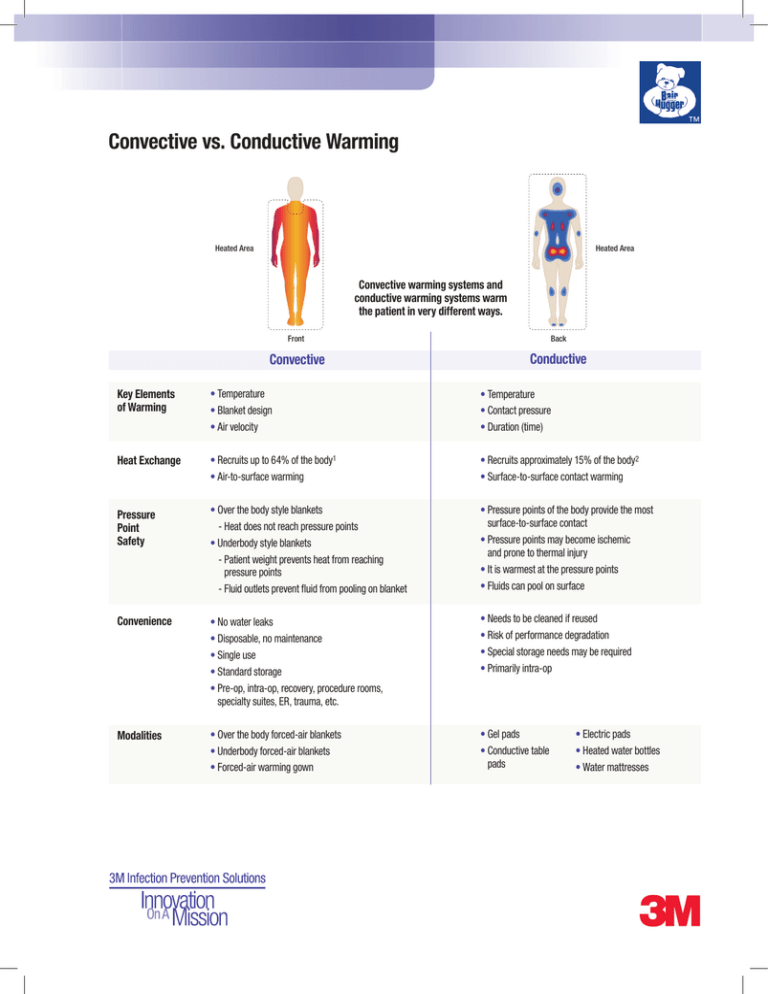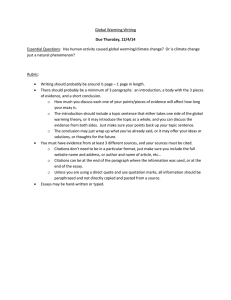
Convective vs. Conductive Warming
Heated Area
Heated Area
Convective warming systems and
conductive warming systems warm
the patient in very different ways.
Front
Back
Convective
Conductive
Key Elements
of Warming
• Temperature
• Blanket design
• Air velocity
• Temperature
• Contact pressure
• Duration (time)
Heat Exchange
• R ecruits up to 64% of the body1
• Air-to-surface warming
• Recruits approximately 15% of the body2
• Surface-to-surface contact warming
Pressure
Point
Safety
• Over the body style blankets
- Heat does not reach pressure points
• U nderbody style blankets
- Patient weight prevents heat from reaching
pressure points
- Fluid outlets prevent fluid from pooling on blanket
• P ressure points of the body provide the most
surface-to-surface contact
• P ressure points may become ischemic
and prone to thermal injury
• It is warmest at the pressure points
• F luids can pool on surface
Convenience
• No water leaks
• Disposable, no maintenance
• Single use
• Standard storage
• P re-op, intra-op, recovery, procedure rooms,
specialty suites, ER, trauma, etc.
•N
eeds to be cleaned if reused
• R isk of performance degradation
• S pecial storage needs may be required
• P rimarily intra-op
Modalities
•O
ver the body forced-air blankets
• U nderbody forced-air blankets
• F orced-air warming gown
• Gel pads
• C onductive table
pads
• Electric pads
• Heated water bottles
• Water mattresses
3
Convective vs. Conductive Warming
More than 100 scientific studies have been written about the benefits of forced-air warming and the prevention of hypothermia. Studies have
shown forced-air warming to be the most effective warming method, in general, for preventing and treating unintended hypothermia.
The Choice is Yours
Forced-air Warming Using an Underbody Blanket
Convective warming systems such as forced-air warming blankets and
conductive warming systems such as warm cotton blankets, resistive electric
covers, heated pads and water mattresses warm patients in different ways.
Because of this, studies have demonstrated that forced-air warming can
warm your patients in a fraction of the time…without delivering heat directly
to pressure points.2,3
•M
ay prevent the initial temperature decrease caused by redistribution
temperature drop 4
•M
ore effective at preventing hypothermia during
abdominal surgery than water mattresses4
• R ecruits greater body surface area and is more effective in preventing
hypothermia during abdominal surgery than an upper body blanket 4
•D
oes not deliver heat under pressure points
-
-
-
-
75 min
90 min
105 min
120 min
10
-
8
60 min
6
-
he
0.0
45 min
Hours
nd hu
ating a
-
4
ation
midific
Airway
2
0.2
nket
n bla
to
1 cot
30 min
ma
-
0
ter
Wa
15 min
1˚C
bl
Underbody Blanket group [FAW]
Control group[water mattress]
p<0.05 compared with 0 min
-
2˚C
ton
ot
3c
0.4
>6hr
ss
ttre
s
et
ank
0 min
ced
-air
3˚C
Changes in Esophageal Temperature4
Temperature Changes (˚C)
2hr
4˚C
For
Change in Mean Body
Temperature (°C)
The Relative Effects of Warming Methods
on Mean Body Temperature3
-0.2
-0.4
-0.6
-0.8
-1.0
-1.2
Time
(As studied in abdominal surgery.)
References:
1. Taguchi, A., et al. Effects of a circulating water garment and forced-air warming on body heat content and core temperature. Anesthesiology. May 2004, Vol 100, No. 5:
1058-64.
2. Hohn, L., et al. Benefits of intraoperative skin surface warming in cardiac surgical patients. British Journal of Anesthesia. 1998; 80: 318-323.
3. Sessler, DI., Current concepts: mild perioperative hypothermia. N Eng J Med 1997; 336: 1730-1737.
4. Aki Tominaga, M.D., Toshiya Koitabashi, M.D., Ph.D., Takashi Ouchi, M.D., Rika Ban, M.D., Eri Takano, M.D. Efficacy of an Underbody Forced-Air Warming Blanket for the
Prevention of Intraoperative Hypothermia. Anesthesiology, 2007; 107:A91.
3
Infection Prevention Division
3M Health Care
3M Center, Building 275-4W-02
St. Paul, MN 55144-1000
1-800-XXX-XXXX
www.3M.com/XXXXXXX
Please recycle. Printed in USA.
© 3M 2011. All rights reserved.
Issued: 3/11 7826HB
XX-XXXX-XXXX-X
3M is a trademark of 3M Company, used under license in Canada.
BAIR HUGGER, RANGER and the BAIR HUGGER and RANGER
logos are trademarks of Arizant Healthcare, Inc., used under
license in Canada.




